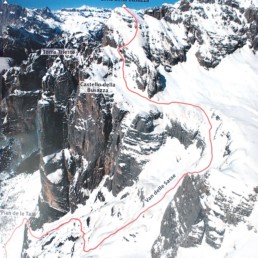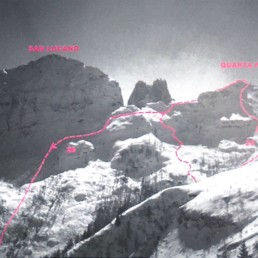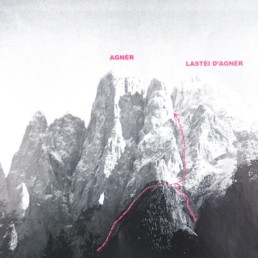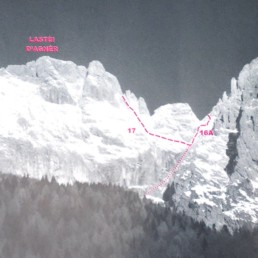Forcella Torre Lastei
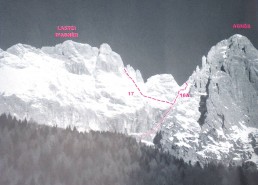
From Frassenè along the Via dei papà
by Diego Favero
It is the vertiginously high saddle that divides the Lastèi d’Agner from the homonymous tower. Impassable along the gorge that sinks into the San Lucano valley, on the contrary, it offers a beautiful itinerary on the eastern side, whose continuity is interrupted only by a very short jump of about twenty meters (which are irrelevant if you consider the overall difference in height). The slopes, especially the upper part ones, are considerable but not to the point to prevent an exciting sequence of curves and instill that feeling of emptiness, a characteristic element of the entire itinerary. Even if they will create new descents in the surrounding areas, that of the Forcella Torre Lastèi is the one that crossed the Lastèi for the first time, those suspended slopes, white until late spring, which characterize the west side of Conca Agordina.
Agnèr
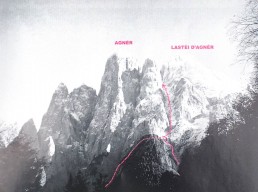
From Col di Pra to Vallon delle Scandole
by Eugenio Bien
Vallon delle Scandole slides with linear verticality between the Armenian Tower and the Lastèi d’Agner. The way it sinks between the high walls of the gray dolomite recalls the Canalone Neri that divides the Tosa from the Crozzon del Brenta. The Agner and the Pale di San Lucano create an environment of extraordinary solemnity, unique in the Dolomites, which arouses admiration and respect at the same time. The ski mountaineering possibilities are few and selective due to the harshness of the terrain, the heavy gradients, and the mountaineering effort required. Vallon delle Scandole, already covered in the mid-1970s, is the itinerary that began the exploration of ski mountaineering in the San Lucano valley. It is the most logical and inviting, perhaps still the most coveted.
Altitude difference: 1800 m
Ascent time: 6 hours and 30 minutes
Quarta Pala Di San Lucano
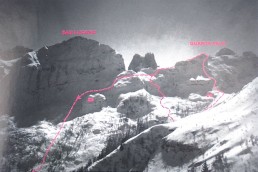
by Ilio De Biasio
The Quarta Pala is one of the great mountaineering temples in the Pale di San Lucano. The names of Alessandro Gogna and Renato Casarotto would be enough to confirm this. The grandeur of its southern pegs (which plummet for kilometers into the Boràl di Lagunàz), together with those of the Terza Pala, Torre, and Spiz di Lagunàz, is unmatched. Moreover, beyond the San Lucano valley there are the even higher and shady walls of the Agner and its satellites. The only ones to reassure us are perhaps the bizarre profiles of the Cima di Pape subgroup. Such a scenario alone would be a sufficient reason to reach such a representative peak even without calling into question the natural skiability of its northern slopes.
A very happy ski mountaineering itinerary explored in the mid-1980s allows us to easily reach the top of the Quarta Pala without exceeding the difficulties and accompanying us with impeccable logic on the beautiful slopes beyond the Forcella di Gardès.
Busazza
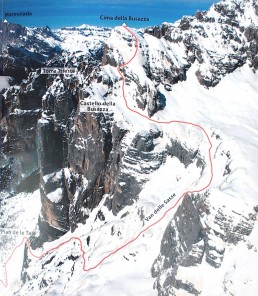
Imposing prestigious pillar of the Civetta Group which offers a skiable slope of high difficulty to the south-east.
Access: from the town of Listolade, near Agordo, take the road in front of the Civetta hotel, which goes up the Val Corpassa towards the Capanna Trieste at 1135 m. In the winter, the road is often closed at around 800 m.
Ascent: go up towards the Torre Trieste, which stands out on the bottom of the Val Corpassa, clearly following the road. Having reached the almost flat stretch at the base of the Tower (Pian de le Taie, at about 1550 m), you leave it and go up a few meters towards the wall. After a few meters, a long traverse begins to the east, roughly on the route of the summer path 558. Once you enter the large basin called Scalet delle Sasse, you go up, taking a slight right to make a last traverse to the left and enter the plain of the final basin. Then you turn left, pointing to Cima della Busazza through a steep gully, always a little to the left of the great east side, up to where it ends on some cliffs. Here a challenging mountaineering passage allows you to access the final slope. Discarding some roughness, you reach the Cima della Busazza.
Descent from the ascent.


